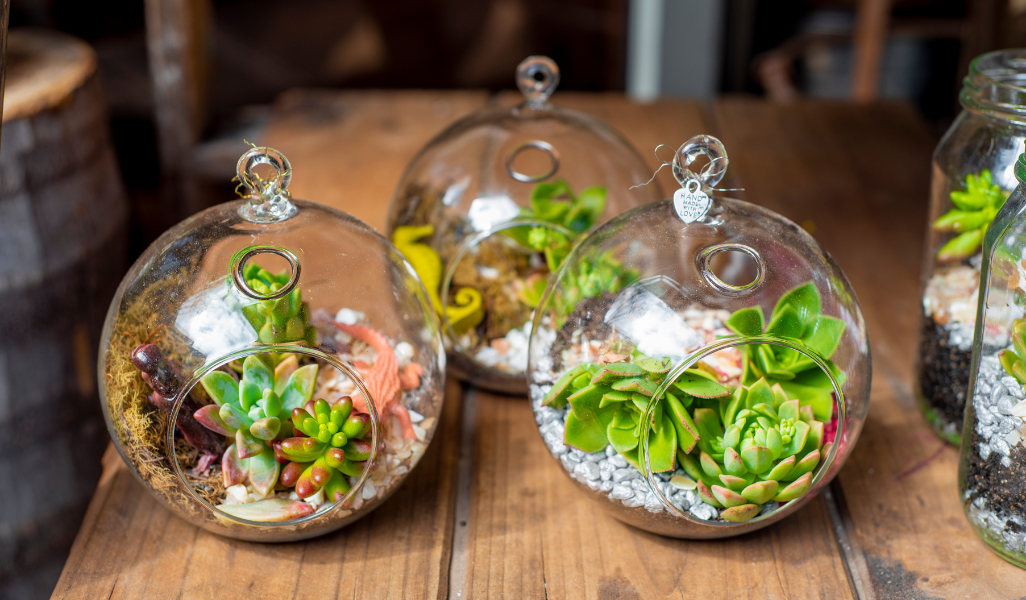12 Indoor Cactus Types
Cacti are amongst the most popular choices for a houseplant or indoor plant collection. Ideal for beginners or nervous plant carers, these are pleasingly easy to care for plants. Hardy and long-lasting, in the right environment, many indoor cactus types tolerate a little neglect such as a sparse watering routine. This means that even if you occasionally forget your little plant it is unlikely to shrivel up and die.
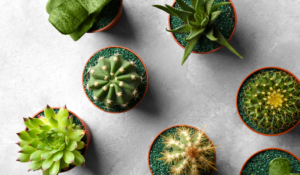
Cacti are amongst the most popular choices for a houseplant or indoor plant collection. Ideal for beginners or nervous plant carers, these are pleasingly easy to care for plants. Hardy and long-lasting, in the right environment, many indoor cactus types tolerate a little neglect such as a sparse watering routine. This means that even if you occasionally forget your little plant it is unlikely to shrivel up and die.
Unlike tropical flowers, many indoor cactus types don’t require high humidity levels in order to thrive. Instead, they prefer dry air and average room temperatures. While many like to sit in a full sun position, most can tolerate as little as 3 hours of light a day. Supplementary lighting, such as grow lights, can also be used.
When happy and healthy most indoor cactus types provide long-lasting greenery and vibrant colorful blooms. Growing into unusual shapes and with tactile, spiky textures, cacti often display a slow growth habit, this helps to make them a low-maintenance option. Easy to care for and packed with visual interest the cacti listed below are amongst the most interesting indoor plants that you can grow.
What is the Difference Between Cacti and Succulents?
Interestingly all cacti are succulents however not all succulents are classed as cacti. Unlike cacti, succulents typically store water in their fleshy foliage. Cacti are more tolerant of hot, direct light positions than some succulents. Cacti also have areoles. These are little bumps on the outside of the plant from which spines or hairs emerge.
Different Indoor Cactus Types
Most indoor cactus types are members of the cactaceae family. As you can see from our list of attractive specimens, these plants come in a range of shapes, sizes, and colors. Mainly succulents, they are also pleasingly easy to care for.
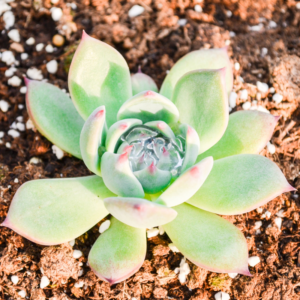
Indoor cactus types can be divided into two groups, desert and forest types.
Most desert types grow in desert climates, these have the traditional cacti appearance. Their bodies, forming in the shape of a ball, obelisk or paddle, are covered in spines or hairs. Prized for their stark beauty and attractive flowers, these are tough little houseplants.
Forest cacti grow in wooded areas such as temperate forests or subtropical areas. Christmas cacti are one of the most commonly grown of the forest cultivars. Many forest cacti are epiphytic or have a climbing growth habit. This makes them ideal hanging plants.
Typically, hardy in USDA Zones 9 to 11, both forest and desert indoor cactus types are slow growing and produce attractive flowers.
The following suggestions are amongst the most interesting indoor cactus types.
1 Angel Wings
The first of our indoor cactus types Angel Wings (Opuntia albispina) is sometimes known as Bunny Ears. Part of the Prickly Pear family, Angel Wings is one of the indoor cactus types that does not produce spikes on its pad-like body. Instead, evenly spaced clusters of hairs emerge. This makes it a good choice if you have small, curious children.
Native to Mexico, the pad-like clusters which make up the body of Angel Wings can reach 2 ft in height. The plants can also spread up to 5 ft wide. However, this size is only achievable if the Angel Wings are grown outside. When cultivated as an indoor cactus, growth is more contained.
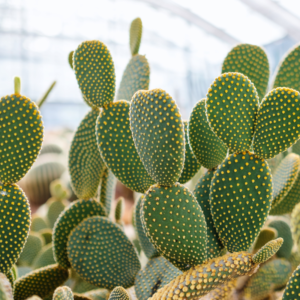
BUY NOW
Further adding to the interest, Angel Wings pads can grow in seemingly random directions. When in flower pale yellow flowers decorate the plant. As these fade red edible fruit forms. Best placed in a full sun position, Angel Wings also tolerates partial light. It does best when given a regular drink of water.
2 African Milk Tree
African Milk Tree (Euphorbia trigona) is another of the easy to care for indoor cactus types on our list. Also known as the Cathedral Plant, the African Milk Tree can reach a maximum height of 8 ft. But don’t let this put you off. The African Milk Tree is a slow-growing specimen. When grown indoors the plant rarely exceeds 4 ft.
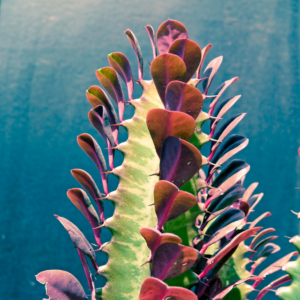
BUY NOW
Best planted in well-draining soil and watered twice a month, the African Milk Tree tolerates both full and partial sun positions. If correctly cared for these plants can last for decades. Be careful when handling your African Milk Tree. Exposure to the sap can cause skin irritation.
3 Aloe Vera
While Aloe Vera plants are most definitely succulents, they are not technically cacti. However, the plants are often grouped as such. Aloe Vera also shares many growing and care needs with many cacti plants.
Identified by their stocky green leaves, sometimes adorned with the occasional white speck, there are over 25 types of Aloe Vera all of which bring a range of health benefits as well as provide visual interest. Thriving in pots and containers, Aloe Vera is reliable and easy to care for succulents. Best placed in a sunny or light spot, the foliage can feel spongy and dense when the plant is well watered.
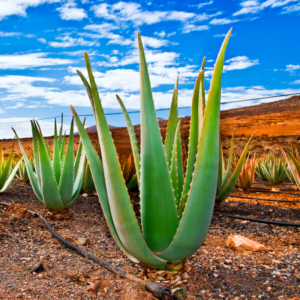
BUY NOW
4 Hens and Chicks
Hens and Chicks (Sempervivum tectorum) is one of the most attractive indoor cactus types. Also known as Sempervivum, Hens, and Chicks is a rosette-shaped succulent. Forming in clusters, the mother plant, or the mother hen, sits in the center. Around it is offshoots or chicks, that develop and spread.
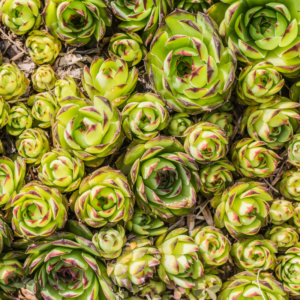
BUY NOW
There are around 40 different Hens and Chicks cultivars in a range of shapes and colors. The most common are red, purple, and green. Easy to care for, Hens and Chicks plants are best planted in a sunny spot. Once established these plants rarely require watering.
5 Christmas Cactus
Another indoor cactus type that lacks teeth or spines, the Christmas Cacti is popular for its smooth, segmented foliage and soft, rounded spines. Flowering at Christmas, it is part of the holiday cacti group. Thanksgiving and Easter flowering types are also available.
Native to the Brazilian rainforests, where they grow as epiphytes on the branches of trees, Christmas Cacti prefer more humid conditions than other indoor cactus types. The room temperature should average around 70 ℉ during the day, dropping to 60 ℉ at night. Water moderately.
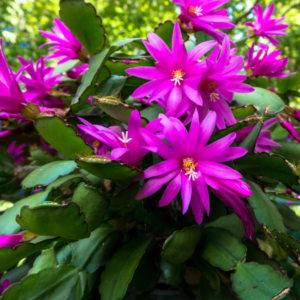
BUY NOW
An easy-to-care-for specimen, as our grow guide shows, red, pink, white, and orange flowering types are available.
6 Saguaro
In the wilds of the Sonoran desert, the Saguaro cacti reach 40 ft in height. Luckily the plant’s slow growth rate, rarely growing more than an inch a decade, means that it can be easily cultivated as a houseplant. Once the plants are mature enough, usually after 40 years of steady growth, white flowers with yellow centers emerge during the late spring and early summer months. As the flowers fade, edible fruits form.
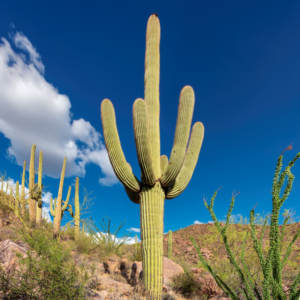
BUY NOW
A majestic specimen, Saguaro cacti can live for up to 200 years. This is a barrel-shaped cacti that thrives in indirect light. Too much direct light may kill it. Water your Saguaro once every few weeks or when the soil dries out.
7 Old Lady
Full of character, Old Lady (Mammillaria hahniana) is a small powder puff-shaped plant. Thriving in arid conditions, the body of the Old Lady is a 10 to 20-inch sphere which is covered with spines and white hairs which can resemble a ball of cobwebs. Happy and healthy specimens also produce a crown-like halo of pink flowers on the top of the body during the summer months. While pink is the most common color, red and purple flowering types are also available.
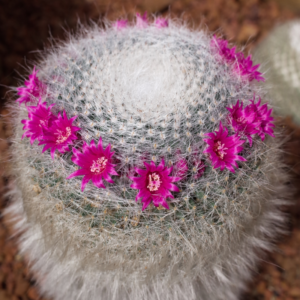
BUY NOW
Best planted in sandy potting soil, water your Old Lady cacti fortnightly. In the winter this can be reduced to watering once a month. Place this attractive specimen on a south-facing windowsill so that it can bask in lots of sunlight. Old Lady also works well in container gardens.
8 Barrel
Barrel cacti (Ferocactus), also known as Mother-in-law’s Cushion, is one of the most fierce indoor cactus types. A muffin-shaped cacti which are covered with long, rigid spines that protect the edible, juicy pulp, Barrel cacti often spill over the edges of their container, providing further visual interest.
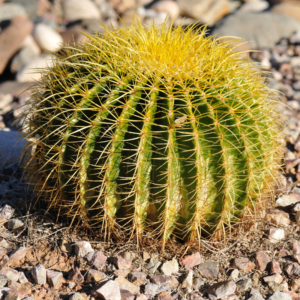
BUY NOW
Producing orange, yellow, and purple flowers in late spring, Barrel cacti can live for decades with the right care. Place in full sun during the spring and summer months, but keep the surrounding humidity levels low. A spot on a south-facing windowsill is ideal. Water sparingly, as little as once every two or three months. Like other indoor cactus types, too much water can harm or even kill the plant.
9 Bishop’s Cap
Native to Mexico, Bishop’s Cap (Astrophytum ornatum) is one of the most striking indoor cactus types. Bishop’s Cap, or Monk’s Hood to use its other common name, can have between 3 and 7 vertical ribs which create a star-like shape when the plant is young. These are covered in stiff, protective spikes. Once the plant is mature, after 5 or 6 years, daisy-like flowers emerge on the top of the body. Bishop’s Cap is particularly attractive when decorative gravel or mulch is placed on top of the soil.
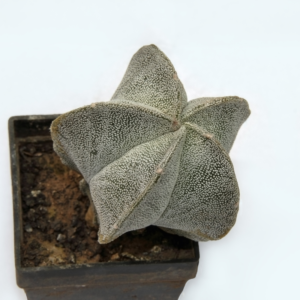
BUY NOW
Bishop’s Cap often develops a white frosty coating that can suggest a disease such as powdery mildew. However this is a defense mechanism, protecting the plant from the sun. Thriving in hot, sunny positions, water Bishop’s Cap regularly during the summer months. You can cease watering completely during the winter months.
10 Ladyfinger
An ideal beginner cacti, Ladyfinger (Mammillaria elongata) or Gold Lace is one of the smaller indoor cactus types. Reaching 6 inches tall, this Ladyfinger forms dense clusters of tubes in green and orange colors. These can look like a hand, hence the name. During the spring white, yellow or pink flowers form.
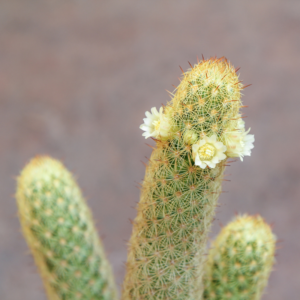
BUY NOW
A small specimen, Ladyfinger can reach a mature height of 8 inches and spread around 12 inches wide. Like many other cacti on this list, Ladyfinger cacti thrive in a sunny position. While fertilization is not required, the plants do appreciate an occasional dose of water.
11 Prickly Pear
One of the more distinctive indoor cactus types upon first glance the Prickly Pear (Opuntia) appears to be two cacti growing on top of each other. The higher radish-like colorful parts emerge from the large padded, leaf-like body. You can also find specimens with large spines, spine-free cultivars, and ones that produce edible fruit in red, green, and yellow-orange colors. Both the fruits and the pads are edible, just make sure you clean them first.
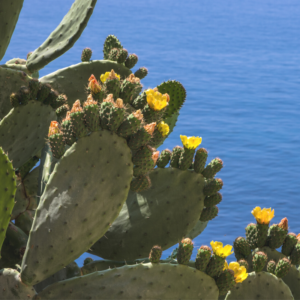
BUY NOW
Water once every 2 to 4 weeks, Prickly Pear thrives when placed in a sunny position. These plants like to mature, growing for around 4 years, before setting fruit and flowering.
12 Snake Plant
One of the most tolerant indoor cactus types, the Snake Plant (Sansevieria) is named because the bodies resemble a snake’s tongue. Hardy and resilient, the Snake Plant thrives when neglected. The plants tolerate both drought and low light levels.
One of the many houseplants that also purify the air in your home, the Snake Plant is a must-have addition to any indoor plant collection. Thriving in indirect sunlight, allow the soil to dry out between waterings. Many specimens also benefit from an occasional dose of fertilizer.
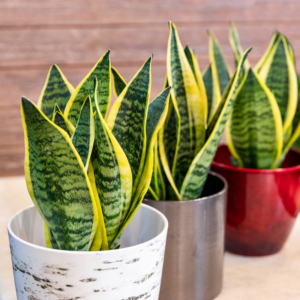
BUY NOW
The most commonly grown Snake Plant is Sansevieria trifasciata or Mother-in-law’s Tongue. However, other attractive cultivars such as the yellow-edged Sansevieria Golden Hahnii are also available.


